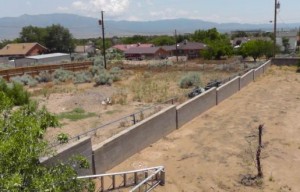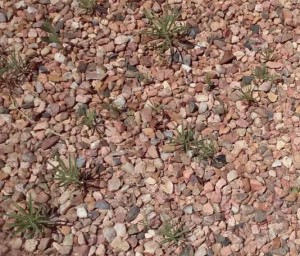Weed Management
What are our weed management options? Mechanical weed management is the physical removal of weeds. Any physical re-moval or displacement of weeds can be classified as mechanical in operation. Cultivation, mowing, hand pulling, and hoeing are ex-amples of this type of management. The success of mechanical weed management depends upon the weeds in question. Annual weeds often are effectively managed this way, while the perennial weed problem can be multiplied through the movement of the underground vegetative reproductive structure by cultivation and other mechanical activities. We have to get the root, and some-times we have to dispose of all pieces of the weed to prevent roots forming from stems or leaf parts. Knowing the weed species tells us what’s required. For instance, check out Troublesome Weeds of New Mexico to see different requirements for specific weeds.

 The photo on top (above) shows herbicide use (near side of wall) versus an untreated area on the far side. The photo on bottom (above) shows a similar area that is occasionally tilled, plus a hoe patrol from time to time. These 2 photos and the first on the previous page are three adjacent lots.
The photo on top (above) shows herbicide use (near side of wall) versus an untreated area on the far side. The photo on bottom (above) shows a similar area that is occasionally tilled, plus a hoe patrol from time to time. These 2 photos and the first on the previous page are three adjacent lots.
Biological weed management involves using living organisms to manage other living organisms. Within the lawn or ornamental arena there are very limited biological options available, and none are discussed here.
Cultural weed management includes practices such as mulching to prevent weed seed germination, and making sure turf is healthy, allowing it to be more competitive and crowd out weeds.
Chemical weed management. Some type of herbicide will always be effective in killing your weeds. Heck, you can kill just about anything with one herbicide or another, and therein lies the problem: herbicides can create more difficulties than they solve if you use the wrong one or don’t use it correctly. And beware – some may even be toxic to pets or humans. Because of the potential damage herbicides can cause, the label is a legal document and must be followed completely. Any deviation from what the label indi-cates is a violation of the law. Black helicopters swoop in and people disappear when herbicides are misused. Well, it could happen.
There are selective herbicides and non-selective herbicides, herbicides with residual activity and herbicides without residual activity, pre-emergence herbicides and post-emergence herbicides. Some work through the leaf surface, some need to get to the roots, and some keep seeds from germinating. So how are we going to select a herbicide? First, we’re going to review our SCMG training ma-terial. Then we’re going to apply that information to our specific weed problem and, IF APPROPRIATE, incorporate herbicides into our IWM plan.
After all those warnings, responsibly applied herbicides can have a place in effective homeowner management of weeds. One exam-ple is 2,4-D for control of broadleaf weeds in turf. This is a perfect example of an herbicide that is selective to dicots (broadleaf plants like dandelion) and is harmless to monocots (like grass). Another example is a non-selective herbicide like glyphosate to elimi-nate weeds along driveways. Your SCMG manual shows some product brands containing these herbicides.
Do some research and determine exactly which weeds you want to control and the best way to manage them. Consider all the weed management options in your IWM toolbox, and select the most appropriate methods. Most of your weed management activity will probably involve good old-fashion weed pulling and hoeing. If you choose to employ herbicides in your IWM, wear rubber gloves and eye protection. Pay attention to label warnings, restrictions, first aid instructions, and application directions. Don’t spray on a windy day. Take a shower and wash your clothes when you are done, because you are dealing with chemicals. Dispose of empty containers per the label.

 If you have too many weeds coming up through your landscape gravel to pull, a non-selective herbicide such as glyphosate could be a solution. For a dandelion infestation in your lawn, a selective broadleaf herbicide like 2,4-D would be a better solution because it won’t harm your grass.
If you have too many weeds coming up through your landscape gravel to pull, a non-selective herbicide such as glyphosate could be a solution. For a dandelion infestation in your lawn, a selective broadleaf herbicide like 2,4-D would be a better solution because it won’t harm your grass.
